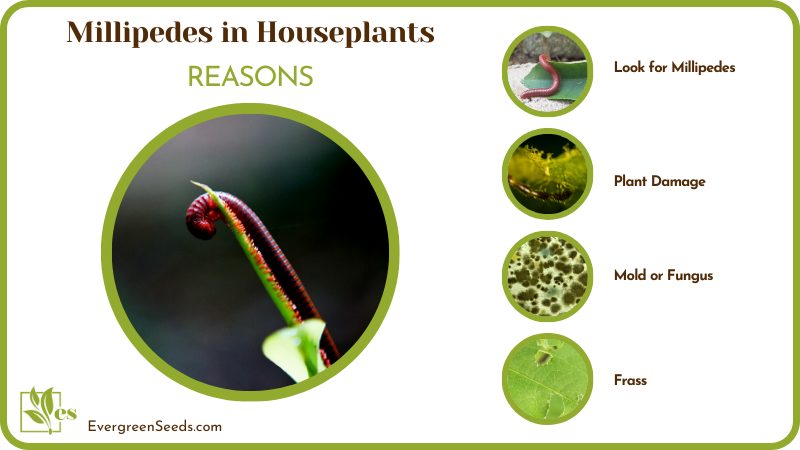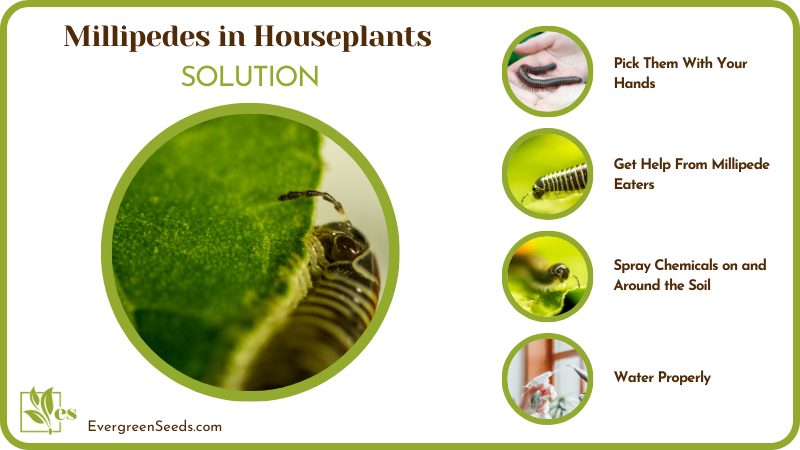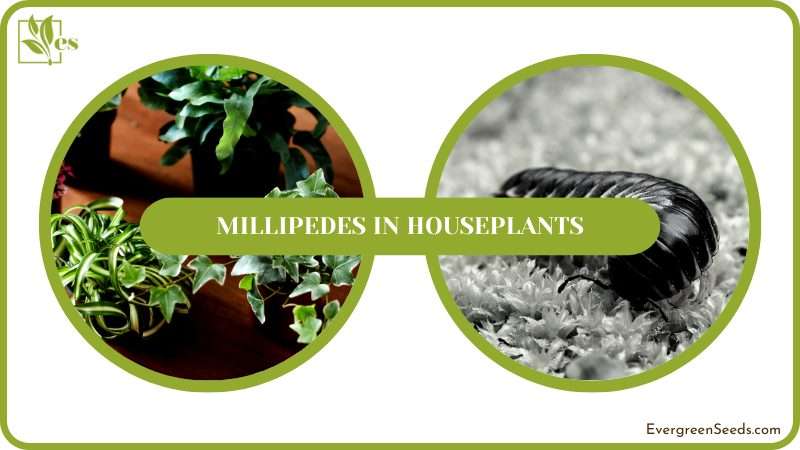Millipedes in houseplants, when spotted, should immediately be removed. Using traps, spraying chemicals, changing the infested soil, applying organic repellents, etc., are all proven ways of doing so.

If you want to find out how to spot and remove millipedes, continue reading until the end.
JUMP TO TOPIC
- How to Know if There Are Millipedes in Houseplants?
- How to Remove Millipedes From Houseplants?
- – Pick Them With Your Hands
- – Use Traps
- – LED Light Traps
- – Get Help From Millipede Eaters
- – Apply Diatomaceous Earth
- – Spray Chemicals on and Around the Soil
- – Change Infested Soil
- – Spray Neem Oil
- – Apply Insecticidal Soap
- – Use Sulfur Powder
- – Add Wood Ash
- – Try Cayenne Pepper
- – Use Boric Acid
- – Keep Your Garden Clean
- – Water Properly
- – Make Sure Pots Are “Crack-Free”
- – Use Other Organic Repellents
- – Give Vinegar a Chance
How to Know if There Are Millipedes in Houseplants?
How you know if there are millipedes in houseplants is twofold: The first one is to thoroughly check the whole plant to spot any unwanted creatures. The second way is to look for any damage, as millipedes have chewing mouthparts.
– Look for Millipedes
Looking for millipedes is the simplest way to know if there is any infestation in your houseplants. They look very similar to centipedes but have more legs. To spot them, look under the rocks, leaves, and logs. They also love to crawl on the soil as well. If you notice them near your plants, chances are they are in larger numbers than you can see.
– Plant Damage
You may have a millipede infestation if you notice damage to your plants. People often wonder – are millipedes bad for potted plants? And yes, they are. This pest can cause serious plant damage by consuming the leaves, stems, and roots.

How to Remove Millipedes From Houseplants?
To remove millipedes from houseplants you can use the following methods: You can set a trap or use organic repellents like DE, Wood Ash, Sulfur Powder, Boric Acid, Baking Soda, and Vinegar. If these organic insecticides do not remove them, try chemical insecticides.
– Pick Them With Your Hands
The easiest way to remove millipedes is to take them off the plants with your hands. After that, you can release them far away from your plants. This strategy only works if you are okay with getting your hands dirty with bugs in the garden.
Don’t squash or stress the millipedes, or you will regret it later. The reason is that when you try to harm this pest, it will produce a chemical that causes a bad odor. Some people may be allergic to this chemical substance as well.
Furthermore, some millipedes can bite to protect themselves, which can cause skin allergies in your hand, but it happens in rare situations. So, if you don’t want to touch them with your hands or want to be extra cautious (which you should), put on a pair of gardening gloves before removing them.
– Use Traps
You can also lure millipedes into a trap and catch them. You can buy traps from any store or create them in your home. A plastic bottle trap is the easiest to make. You need a few items: A vinyl tube, a plastic water bottle, and fruit. To make things easier, purchase tubing that fits perfectly into the bottle’s mouth.
- Start by putting a ripe fruit into the plastic bottle.
- Then, insert the top two inches of the vinyl tubing into the bottle’s mouth. Make sure the tubing is not touching the bottle’s sides.
- Then, fix the tube to the bottle with the help of tape.
- Place this trap in millipede-infested soil. The millipedes will be attracted to the fruit and fall into the trap.
– LED Light Traps
Millipedes have a weakness. They are attracted to light, so setting up a light trap is also a good way to capture them. However, it is tricky to set up such a trap. Therefore, people prefer to use other ways to control millipedes.
- First, make a deep enough hole in the garden near the infested plants to make a light trap using a shovel. The hole should be sufficient to fit the food container.
- Cover the sides of the container with dirt to ensure that it is tight and does not shift or have any gaps. Then, fill the food container halfway with water.
- Next, cut some thin slits in the bucket’s top with the cutters. The millipedes will be able to enter the bucket through these slits.
- Then, place the LED source on the bucket’s bottom and put the bucket upside down on the water-filled food container. The trap is ready!
At night, switch on the battery-powered LED so the millipedes are drawn to the warm light. They will enter the bucket, fall into the food container filled with water, and drown.
In the morning, remove the bucket and inspect the food container for millipedes. Then discard the water and replace it with new water.
– Get Help From Millipede Eaters
When you see white millipedes in houseplants, you can get help from other animals. Many predators love to eat millipedes. So if you can bring them into your garden, the millipede population will decline.
The animals that love to feed on millipedes are toads, spiders, ground beetles, ravens, common pigeons, yard shrews, pond frogs, ants, etc. The only inconvenience you will face with this method is bringing these animals to your garden.
– Apply Diatomaceous Earth
Diatomaceous Earth, or DE, is a natural killer that effectively eliminates arthropods such as millipedes. This powder has razor-sharp crystals that puncture the tough exoskeletons. Millipedes crawling through the DE will have micro punctures all over their bodies. These sharp borders cut the Arthropods’ outer shells, causing external and internal damage. As a result, millipedes will die shortly.
If you want to avoid dispersing the Diatomaceous powder in the soil, spray it on affected houseplants instead. Moreover, always follow some precautions (like wearing a mask and gloves) when spraying the Diatomaceous Earth powder.
– Spray Chemicals on and Around the Soil
If the millipede population goes out of hand, try spraying chemicals on them. The chemicals are fast-acting and can kill the millipedes swiftly. The best ones are Bendiocarb, Cyfluthrin, Carbaryl, Propoxur, and Pyrethrin. So, purchase insecticides that include one or more of these chemicals and eliminate millipedes in no time.
But there’s a catch – chemicals will remain in the potting soil mix for some time. Furthermore, you must follow the dosage instructions and precautionary measures carefully to avoid any more problems. It is because excessive pesticide application may permanently deplete the soil’s nutrients, kill beneficial insects, and cause more damage to the plant, potentially killing it.
– Change Infested Soil
If the population of millipedes has gotten out of hand and there appears to be no efficient means to control them, it is better to eliminate the infested soil. Remember, you have to discard the soil rather than the complete plant.
After you have discarded the soil, move your favorite houseplant from its old container to a clean one. The new pot should be sterilized and properly cleaned. Put the plant in this pot and fill it with fresh potting soil by following these steps:
- Holding the plant’s base, gently tap on the pot to loosen the root ball.
- Then remove as much old potting soil as possible from your roots.
- After this, make a hole in the center of the new pot.
- Insert the plant’s roots into this hole and ensure that the plant stands upright.
- Add some more soil and then apply water.
Do not simply discard the old soil, as the millipedes may crawl back toward the new pot if it is too close. You should first soak the infested soil in a bleach water mixture (1:9) solution. Then, let it dry and fill it all in a bag. It would help if you disposed of this bag at a far-off location.
– Spray Neem Oil
Neem oil, an insecticide, is made from the seeds of Indian neem plants. Gardeners now prefer neem spray because, compared to other organic methods, it kills pests and repels them. It is because insect pests don’t like the smell of neem, so its spray is efficient. Be sure that the neem oil is not expired to avoid unwanted results.

To make the spray at home:
- Combine 12 teaspoons of oil naturally extracted from neem with one teaspoon of mild liquid soap.
- Add this mixture to 1 liter of lukewarm water.
- Mix all these ingredients thoroughly and spray them on your plant to eliminate millipedes.
– Apply Insecticidal Soap
Soap sprays are a safe, effective, and affordable option to remove millipedes and other common houseplant pests from your garden. They have no unpleasant residue and can be used on any plant. Furthermore, soap sprays do not harm the most beneficial insects.
Insecticidal soap kills insects by suffocating them. Furthermore, This soap also disrupts the insect’s cellular membranes and removes protective waxes that cover the insect, which leads to dehydration. A dehydrated insect can’t live long. Although millipedes are not insects, insecticidal soap is super effective against them.
This soap is typically used in concentrations ranging from 1 to 2 percent ( 5 teaspoons per gallon). It would help if you always read the product label before using it. Also, please do not attempt to use it at higher concentrations, as this could be extremely dangerous.
– Use Sulfur Powder
Sulfur smells bad, which millipedes hate. So, it is effective in keeping them at bay. You can buy pure sulfur and sprinkle it around the house. You can also make a sulfur spray applied to the soil.
If you decide to make a sulfur spray, don’t apply it directly to the pests. It is because sulfur is a repellent and not a pesticide. This product will not kill millipedes but will keep them at bay. Furthermore, refrain from using sulfur in places where you spend a lot of time. The reason is its bad smell, which makes breathing hard.
– Add Wood Ash
Wood ash is a natural millipede repellent. It is available at hardware stores, other specialist sellers, and online. Experts recommend combining the wood ash and your outdoor soil to decrease the insect and centipede population. When you use wood ash, female millipedes will not be able to deposit eggs in the soil. This makes millipede reproduction difficult and disrupts their life cycle.
In addition to repelling insects and millipedes, this ash acts like a sponge. It soaks up excess water in the soil, which lowers the total moisture level. So, be careful about water stress if you decide to apply pesticides.
– Try Cayenne Pepper
Cayenne repels a wide range of insects and centipedes, including millipedes. The great thing about pepper is that it is completely natural and organic. It also has a long-lasting residual impact, so you don’t have to use it frequently.
Sprinkle some cayenne around your home’s furniture and entry spots, such as patio doors, crawl spaces, vents, and windowsills. It is because millipedes crawl from these locations to reach the potted plants.
– Use Boric Acid
Applying Boric acid is another way to get rid of millipedes. This acid has sharp tiny edges that kill the millipedes by harming their outer covering. The best part about it is that it is safe to use and doesn’t even affect pets & kids.
– Keep Your Garden Clean
Millipedes feed on decaying plant materials such as leaves, stems, roots, and rotting fruits. So, clearing plant debris as quickly as possible is better to prevent millipedes’ attack. You can pick the debris by hand or mulch with dry leaves, grass clippings, or wood chips.
– Water Properly
Too much water in the soil can produce a moist atmosphere that invites millipedes. That is why you will find them more on such plants where the soil is moist. So, it is critical that you water plants adequately.
If you keep your potted plants in a tray, remove the excessive trapped water after each watering. If you use pots/containers, you should only add water when the soil around the roots dries. Furthermore, make sure the soil drainage is smooth too. Generally, drainage gets slow when there is clogging in the pothole. So, get rid of it to improve the excess water drainage.
– Make Sure Pots Are “Crack-Free”
Millipedes make this space their home if your pots have cracks and lay eggs there. The reason is that it is easier for them to survive in wet, dark hiding areas. Inspecting your pots daily to spot cracks or fissures is best.
Pots usually crack when you relocate them to a different location. Furthermore, if a pot is old and has been in use for years, there will come a point when it starts to break. The only thing you can do is when you find cracks, use caulk to seal them up. If the crack is too large to be repaired, replace your pot immediately.
– Use Other Organic Repellents
Gardeners prefer to use organic repellents because they don’t have any side effects. The one that is specifically effective against millipedes is beneficial nematodes. The millipede consumes these nematodes, which then perforate its intestines, causing their deaths. In case of severe infestations, beneficial nematodes should be applied every 3 – 4 days or until the infestation has subsided.
The best part about using nematodes is that they only infect millipedes; they do not affect other animals or plants. In addition to nematodes, trying baking soda and essential oils will also help.
– Give Vinegar a Chance
Applying vinegar is another proven way to control the millipedes. It acts as a repellent, so you won’t see any millipedes and insects roaming around when you add it. But will vinegar kill millipedes too? The answer is yes.
Add vinegar and water in equal amounts in a bucket or a bottle and pour the mixture on the soil or spray on the infested area. You will see the effects of the application within two to three days.













